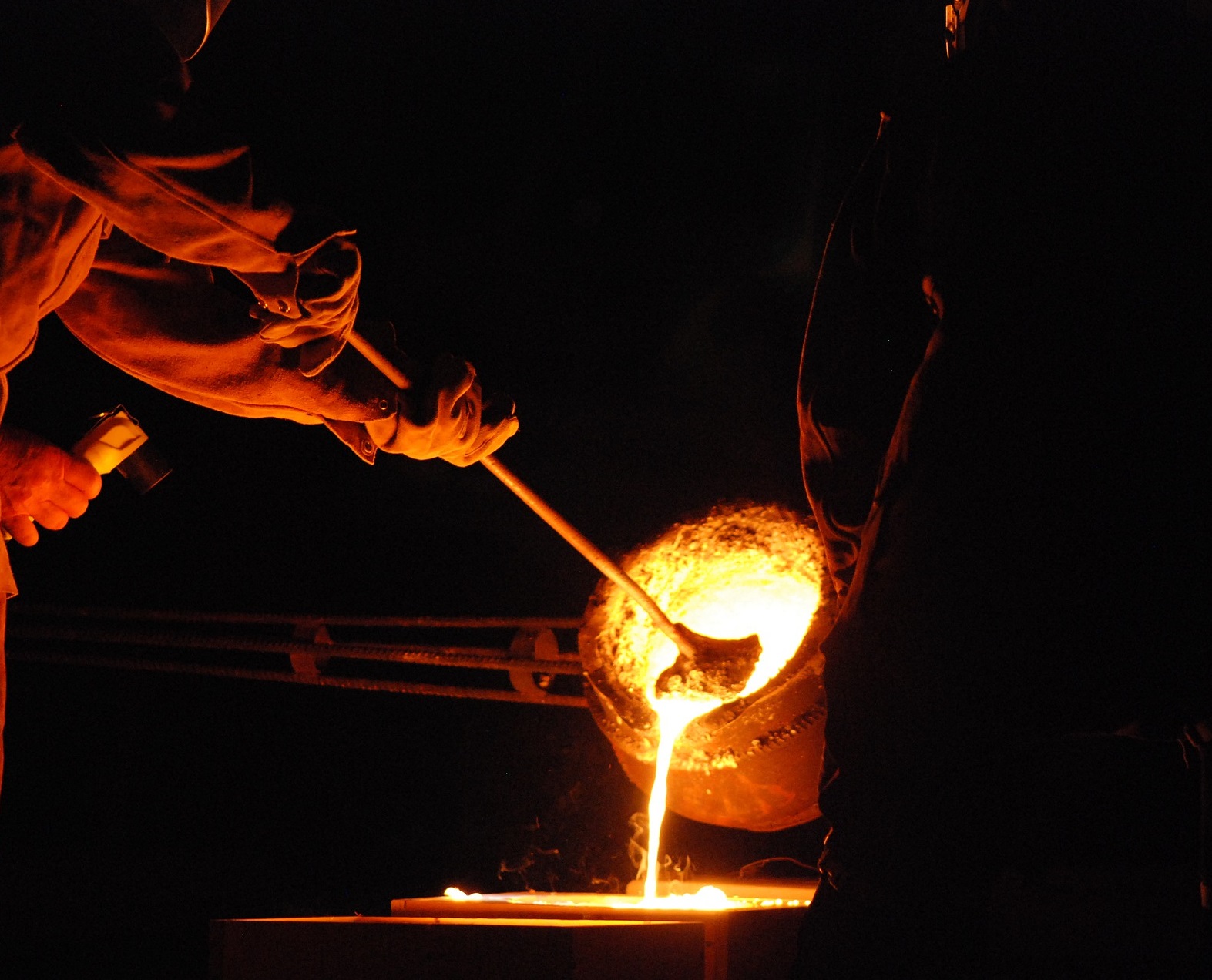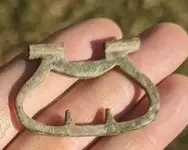paleomaxx
Hero Member
- Joined
- Aug 14, 2016
- Messages
- 841
- Reaction score
- 6,888
- Golden Thread
- 6
- Location
- Upstate, NY
- 🥇 Banner finds
- 6
- Detector(s) used
- Deus XP
- Primary Interest:
- All Treasure Hunting
Been awhile since I last posted here! I've been digging as much as possible, but mostly posting on Instagram as I've been trying to build myself up to maybe doing long-format digging videos or something similar. Getting the hang of all that has been a slow and time consuming process for me though! 
I just found this over the weekend and had to post it here in part because I'm really curious to see if anyone else has found anything like it! I'm pretty confident in my assessment of it, but the idea that I discovered a new type of GWI button is just so unfathomably crazy that I would love some input!
The site is an early Dutch settler's house that I stumbled on this past summer. It's completely buried in thick, woody scrub and to detect anything I have to cut down every single one and drag it away to get at the ground. Fortunately the landowner is 100% on board with that, but it's a ton of work and very slow so I can only do small sections at a time. This past weekend I cleared a little area next to the cellar hole itself and was pulling out some nice relics and even a draped bust half cent! I got a choppy tone and from the same plug I pulled a brass flat button, iron rod, and a big pewter button. At first the pewter button looked plain, but it air dried and I could start to see a design on the face:

Quickly I realized I could see wings! I was still thinking possibly military, so I packed a little baggy with the button and dirt so I could work on it at home. The edges were crumbling a little so I knew cleaning it without loosing edge chunks would be tricky. My technique with these is to do a very cursory clean of the reverse and edges with water and let it almost completely dry on the back, with the front siting on a damp towel. Once the back is mostly dry, I seal it and the edges with several coats of the 50/50 glue and water mixture and let it completely dry. At that point I can work on the front with the button at least partially stabilized. The front was just very slow and careful work with an Andre's brush, but as the pewter polished down, I could see more and more of the design appear and it became clear what I was!


Classic heraldic eagle with two bands of edge beading! It even had a six-pointed start above the eagle's head which is what really clinches it for me as a GWI button. It's a little tough to see in the above photo, but with some more extreme light shading the star starts to pop out:

It's pretty much identical to the heraldic eagle and estoile style buttons except that the material is pewter and the image is mirrored. The eagle is still facing towards the olive branch, but they're in the left talons on this button. I don't think the maker did this intentionally, I think instead this is a less sophisticated button maker who used one of the brass ones as a model and inadvertently mirrored the central design.
The GWI buttons were popular, but expensive, so it isn't too far fetched that a local pewter button maker would try to put out their own version to capitalize on the fervor. The dual circles of beading show that there was still a high degree of craftsmanship and the button maker certainly intended this to be part of a high-quality set. I'm mostly just surprised that there aren't other examples out there. I did look around and there are some smaller GWI eagle buttons, but they seem to universally be brass or copper. There's a script "GW" button that's pewter, but very few examples seem to exist of that one. Could be a similar situation though where a pewter smith put out a limited number locally and they just weren't made in large numbers so few have survived.
This is definitely the crown jewel of the site so far, but there are many other 18th century and later relics from this spot. The intact rat-tail pewter spoon is pretty rare for me:


Nice handful of smaller relics including an absolutely gorgeous openwork dandy button:

Finally a surprisingly intact pewter wick assembly from a whale oil lamp:


This has been such an incredible site, and I've only cleared about 1/3 of it so far! I'm really hoping more GWI buttons from the set are around and maybe even in a better state of preservation! Even if I don't find more, finding just this one will make clearing all that ground worthwhile and if I really have found a new variety talk about a piece of history!!!

I just found this over the weekend and had to post it here in part because I'm really curious to see if anyone else has found anything like it! I'm pretty confident in my assessment of it, but the idea that I discovered a new type of GWI button is just so unfathomably crazy that I would love some input!
The site is an early Dutch settler's house that I stumbled on this past summer. It's completely buried in thick, woody scrub and to detect anything I have to cut down every single one and drag it away to get at the ground. Fortunately the landowner is 100% on board with that, but it's a ton of work and very slow so I can only do small sections at a time. This past weekend I cleared a little area next to the cellar hole itself and was pulling out some nice relics and even a draped bust half cent! I got a choppy tone and from the same plug I pulled a brass flat button, iron rod, and a big pewter button. At first the pewter button looked plain, but it air dried and I could start to see a design on the face:
Quickly I realized I could see wings! I was still thinking possibly military, so I packed a little baggy with the button and dirt so I could work on it at home. The edges were crumbling a little so I knew cleaning it without loosing edge chunks would be tricky. My technique with these is to do a very cursory clean of the reverse and edges with water and let it almost completely dry on the back, with the front siting on a damp towel. Once the back is mostly dry, I seal it and the edges with several coats of the 50/50 glue and water mixture and let it completely dry. At that point I can work on the front with the button at least partially stabilized. The front was just very slow and careful work with an Andre's brush, but as the pewter polished down, I could see more and more of the design appear and it became clear what I was!
Classic heraldic eagle with two bands of edge beading! It even had a six-pointed start above the eagle's head which is what really clinches it for me as a GWI button. It's a little tough to see in the above photo, but with some more extreme light shading the star starts to pop out:
It's pretty much identical to the heraldic eagle and estoile style buttons except that the material is pewter and the image is mirrored. The eagle is still facing towards the olive branch, but they're in the left talons on this button. I don't think the maker did this intentionally, I think instead this is a less sophisticated button maker who used one of the brass ones as a model and inadvertently mirrored the central design.
The GWI buttons were popular, but expensive, so it isn't too far fetched that a local pewter button maker would try to put out their own version to capitalize on the fervor. The dual circles of beading show that there was still a high degree of craftsmanship and the button maker certainly intended this to be part of a high-quality set. I'm mostly just surprised that there aren't other examples out there. I did look around and there are some smaller GWI eagle buttons, but they seem to universally be brass or copper. There's a script "GW" button that's pewter, but very few examples seem to exist of that one. Could be a similar situation though where a pewter smith put out a limited number locally and they just weren't made in large numbers so few have survived.
This is definitely the crown jewel of the site so far, but there are many other 18th century and later relics from this spot. The intact rat-tail pewter spoon is pretty rare for me:
Nice handful of smaller relics including an absolutely gorgeous openwork dandy button:
Finally a surprisingly intact pewter wick assembly from a whale oil lamp:
This has been such an incredible site, and I've only cleared about 1/3 of it so far! I'm really hoping more GWI buttons from the set are around and maybe even in a better state of preservation! Even if I don't find more, finding just this one will make clearing all that ground worthwhile and if I really have found a new variety talk about a piece of history!!!
Upvote
61








 !!!!!!!!!!!
!!!!!!!!!!!